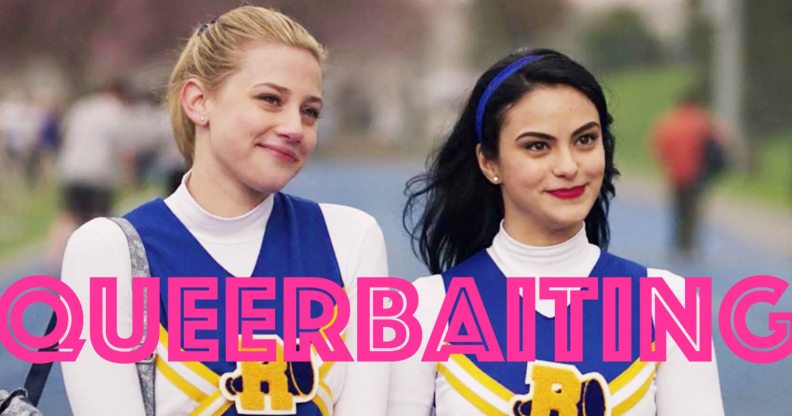Queerbaiting: What is it and why is it a problem?

Picture this: You’re watching your favourite TV show, thrilled as your favourite same-sex characters draw near their inevitable union…
And then they don’t get together. Instead they end up in-hetero-love – and you’re forced to endure more straight couples, alongside the 74 current heterosexual twosomes.
Yep, you’re a victim of Queerbaiting – a term which refers to authors, writers, or show runners (etc) attempting to attract an LGBT audience by hinting at same-sex relationships between characters, though they’re never actually consummated…
By adding homoerotic subtext or erotic tension between two characters, usually leads, LGBTQ audiences are enticed to tune in, unaware that there was never an intention to elevate the subtext to an actual relationship.
Bleugh.
Why is it called Queerbaiting?
If you’ve not figured it out already, it’s called Queerbaiing because it involves attracting (baiting) a queer audience…
Yep, the powers that be use LGBTQ characters and relationships as bait, in order to appeal to the gay dollar and the queer views, without actually following through.
It’s just enough to keep LGBT people interested, without having to really represent us.
No, not this type of Queerbaiting…
Urban Dictionary defines Queerbaiting succinctly as: “When an author/director/etc. gives hints, and clever twists to paint a character as possibly being queer, to satisfy queer audiences, but never outright says they are so they can keep their heterosexual audience.”
However, it also defines another type of Queerbaiting as…
“When a politician, pundit, or other public figure brings up the completely irrelevant detail about a person’s sexuality, true or untrue, as a way of subtly channeling homophobia to attack them.”
Just to be clear, we’re talking about the former nonsense, and not the latter.
y tho?
Related: 12 lesbian movies that you absolutely must watch
WHYYYYYY? Won’t somebody please think of the LGBTQ children!
According to GLAAD’s Where We Are On TV Report, in the 2017-2018 TV season, there were 901 main characters on broadcast scripted primetime programming, and 58 (6.4 percent) were identified as gay, lesbian, bisexual, transgender and/or queer.
Like queer characters, queer viewers are a minority – and it’s thought that Queerbaiting is a way of appealing to them without alienating their main audience, who may be uncomfortable with openly queer characters, or who may not care about them.
So, via Queerbaiting, writers and/or creators are able to appeal to the LGBTQ market, while avoiding any backlash from the strange homophobic market.
Except, of course, this has repercussions for the queer audience…
Some feel that a lack of real representation suggests that LGBTQ characters are second-rate and less worthy of decent stories. Others argue that Queerbaiting sends implies that queer relationships are less valuable, and more, well… farcical.
Queerbaiting on TV
In 2014, TV Guide argued that Supernatural has a Queerbaiting problem. The article stated: “Supernatural producers have undoubtedly profited from the Destiel ship [characters Dean and Castiel] and encouraging ambiguity in Dean’s sexuality.
“As Cas and Dean’s relationship took on more importance in the series (and became based more heavily on romantic tropes) in Seasons 8 and 9, the ratings increased.”
The TV Guide article, via Oakridger, also argued that “Supernatural producers do not support canonical Destiel”, “as the 200th episode made abundantly clear”.
Other shows criticised for Queerbaiting include House (Gregory House and James Wilson), Merlin (Arthur Pendragon and Merlin), Once Upon a Time (Emma Swan and Regina Mills), Sherlock (John Watson and Sherlock Holmes), The OC (Marissa Cooper and Alex Kelly) and Rizzoli & Isles – whose writers and cast have actually admitted to playing up a lesbian subtext between the two leads, Jane Rizzoli and Maura Isles.
Fans also accused Riverdale – which features close friends Betty and Veronica – of falsely implying the two characters would get together after the pair kissed in order to seem risqué. (They were called out by other characters on the actual show for perpetuating that tired trope, too.)
queerbaiting in film (and theatre)
Related: The 12 best ever lesbian characters on TV
Queerbaiting isn’t limited to TV, though – as writers of Harry Potter and The Curse Child discovered when they were accused of “reeling” LGBT fans in.
“The writers of the Cursed Child intentionally included this fan theory to draw us in, but decided to change it just enough so that they wouldn’t have to admit that they made two 11-year-olds gay,” LGBT campaigner Jameson Ortiz told The Guardian.
“It’s queerbaiting because they knew exactly who they were reeling in and why, but still decided to leave out the main attraction for all the fans they hooked.
“Instead [they], like so many others, set up the gay romance, hint at it constantly, make it believable and deep and perfect, and then force it out of the story.”
The live-action Beauty and the Beast adaptation also gave the LGBTQ community hope by announcing Lefou as the “first openly gay Disney character,” with an “exclusively gay moment”. It didn’t exactly live up to expectations.
The Power Rangers reboot was supposed to feature a lesbian Yellow Ranger too, but her sexuality barely got more than a mention, while Ghost in the Shell, starring Scarlett Johansson, was accused of both white washing and Queerbaiting.
thank f*** for oitnb – and some other tv shows
Fortunately for us queers, there are a fair few shows feeding us more than insulting crumbs. If you’re sick to death of Queerbaiting and being underrepresented, there are a number of TV series featuring complex LGBTQ characters, including The 100, Orange is the New Black, Jane the Virgin, Grey’s Anatomy, Game of Thrones, The Handmaid’s Tale, Orphan Black, and Pretty Little Liars.

